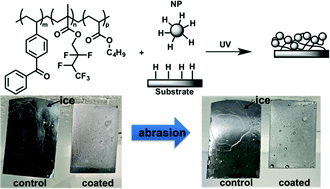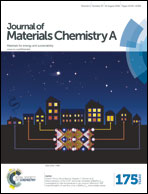Permanently grafted icephobic nanocomposites with high abrasion resistance†
Abstract
In this work, a series of copolymer/silica nanocomposites are investigated that exhibit excellent anti-icing behavior and can be covalently grafted to any substrate containing C–H bonds with high durability. The copolymers of interest consist of pendant benzophenone, hexafluorobutyl, and a variety of other comonomers that, under mild UV irradiation, can be covalently grafted on a variety of substrates and generate a densely cross-linked network of polymer and well-dispersed nanoparticles. The robustness of thin films was compared in a series of terpolymers with different acrylic comonomer content. Thin films prepared with tert-butyl ester side groups had less backbone chain scission and, therefore, a greater extent of cross-linking than films prepared with n-butyl ester side groups. The iso-butyl acrylate comonomer promotes photoreaction efficiency in terms of kinetic rate and network robustness, leading to films that can sustain high shear forces and abrasion. The anti-icing capability of the composite was investigated using the impact of supercooled water on different substrates. The composite maintains its icephobicity after modified Taber testing with multiple abrasion cycles using a 300 g load, which demonstrates excellent mechanical resistance. In addition, this study has led to rational design rules for copolymers that maximize permanent attachment of different surface functionalities in terms of both grafting density and reaction kinetics.


 Please wait while we load your content...
Please wait while we load your content...